Rover and MG PG1 Worn Gearbox Bearings
Discussion
Over the years, I've replaced the three bearings on several of these gearboxes which are prone to wear and run roughly. Wearing particularly if lubricant escapes via worn seals, runs low and the gearbox overheats. These gearboxes are sometimes described as weak. That's a little unfair. Any gearbox with insufficient lubricant will weaken.
Here's the three bearings ~ actually there's four that usually need renewal as there are in fact two 6208 bearings carrying the differential ~ that's the largest diameter one with nine balls shown on the left in this picture. The other bearings have seven balls. Each gearbox has two of these nine ball 6208s :~
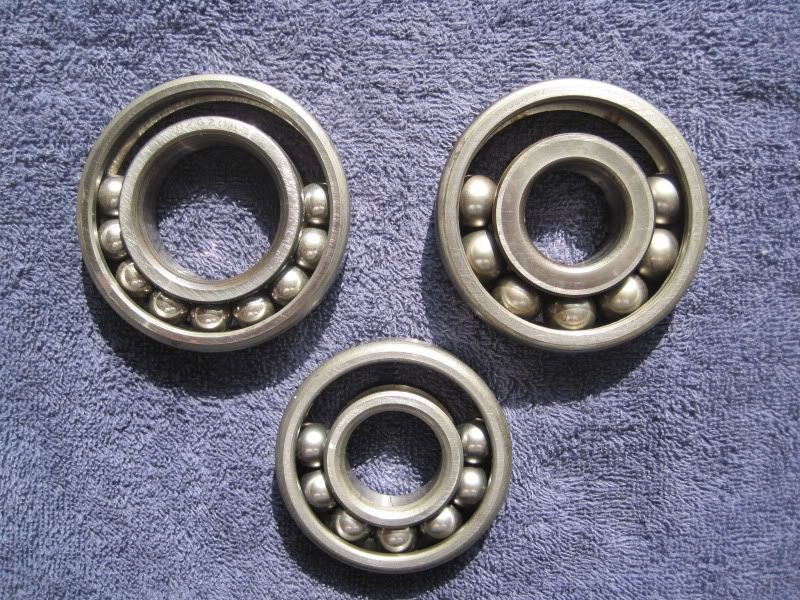
Here's a close up of the worn out 6208 showing some pitting around most of the inner race :~
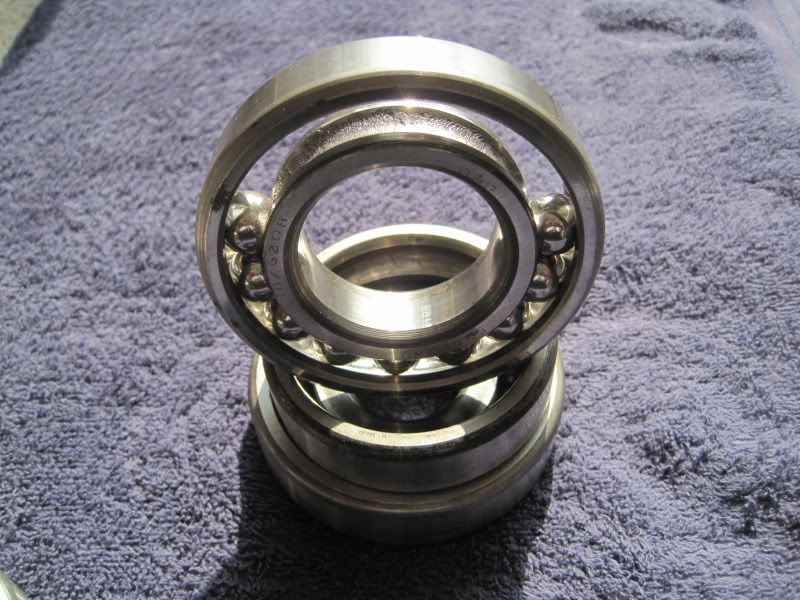
Here's an even closer close up showing the wear damage to the 6208's inner race :~
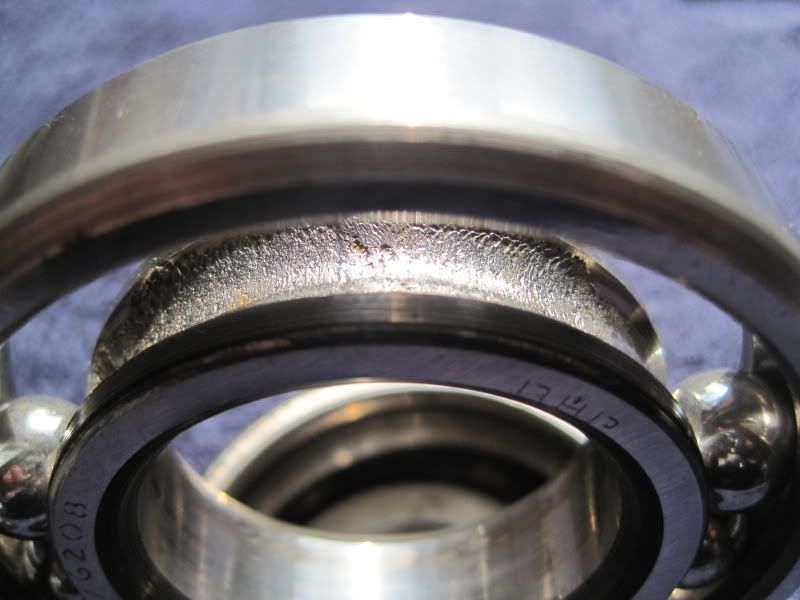
All these bearings ran rough when turned manually. Inside the gearbox with far more power applied it is easy to understand why they would be so noisey and rough running.
I have removed the nylon/plastic ball cages from each of these worn bearings. Incidentally, that plastic stuff is very strong. Almost as hard as metal as I discovered when I first tried to remove the plastic ball cages. It needed a cold chisel and a heft blow with a 4lbs Club Hammer to remove them. They are really strong.
There are two of the larger 6208 differential bearings. This is what it looks like on the differential :~
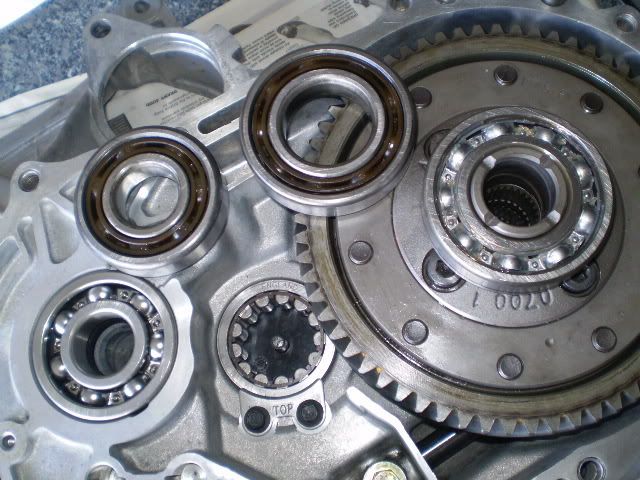
I have already replaced the original plastic caged bearing with a steel caged item on the differential. The other 6208 is unseen on the other side of the differential in the gearbox housing. The old plastic caged worn 6208 is just to the left.
Also in the picture is the Input shaft bearing housed in the ... bell housing. Again the steel caged new bearing is already in place with the old plastic caged item to the right. This is the smaller of the three bearings. Here's a closer view of the old and new Input shaft bearing :~
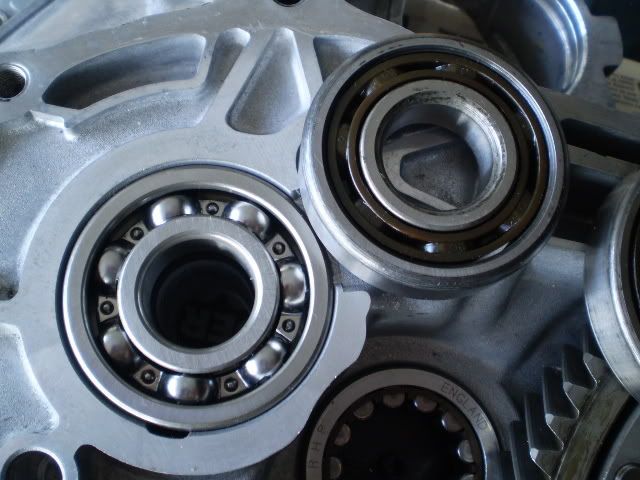
The last bearing is the one that sits on the other end of the Input shaft. A new steel caged version is shown here in its location :~

I have renewed these three bearings in about a dozen PG1 Gearboxes over the years. In this limited experience, they are usually the only bearings that are prone to wear seriously, often as a result of progressive loss of lubricant over the years and miles. There are other bearings in the gearbox but, these are less prone to wear even when lubricant levels have run low.
Here's a picture of a friend's PG1 where the differential bearing's plastic cage housing the nine balls has broken up through lack of lubricant from resulting overheating. Note how the balls have aggregated to the one side instead of being equally spread around the whole race and held in place by the ball cage before it broke up..
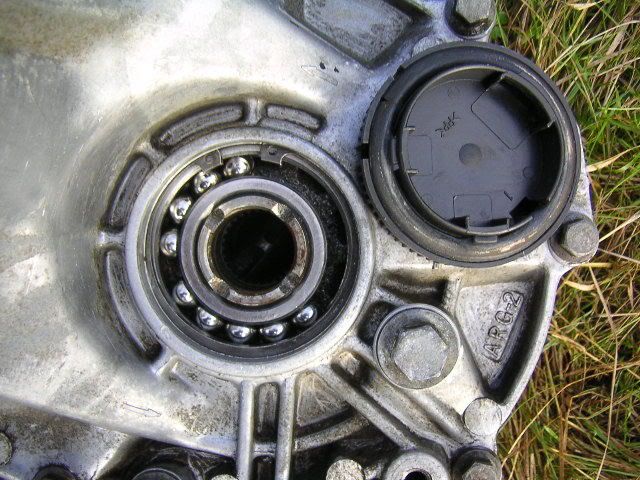
When I acquire a used Rover or MG with one of these gearboxes, one of the first things I check is the gearbox lubricant. I check for correct grade and quantity. One badly 'failed' gearbox did not have the required 2.2 litres of correct lunbricant in it ~ it had this ~ less than an eggcup full!
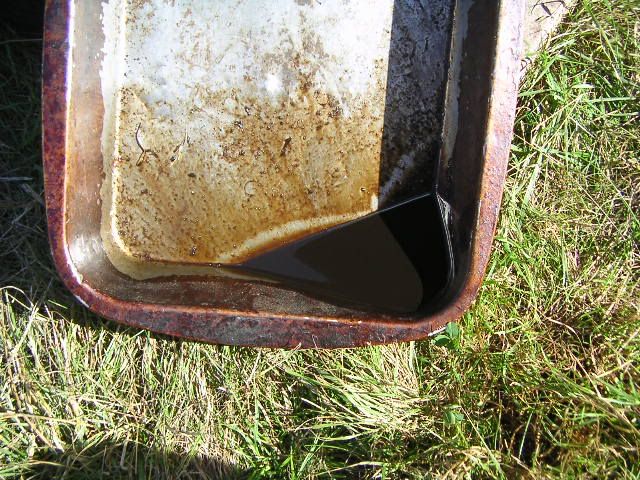
Here's my check on another gearbox which showed the correct volume and quality of lubricant :~

A few days after I bought the car with known faults, I found in the damaged gearbox car a chitty under the driver's seat. It showed a respectable 1/4 mile time down the strip at Santa Pod a week or so before I got it. No bluddy wonder the gearbox gave trouble with only an eggcup of lubricant and that level of abuse...
Here's the three bearings ~ actually there's four that usually need renewal as there are in fact two 6208 bearings carrying the differential ~ that's the largest diameter one with nine balls shown on the left in this picture. The other bearings have seven balls. Each gearbox has two of these nine ball 6208s :~

Here's a close up of the worn out 6208 showing some pitting around most of the inner race :~

Here's an even closer close up showing the wear damage to the 6208's inner race :~

All these bearings ran rough when turned manually. Inside the gearbox with far more power applied it is easy to understand why they would be so noisey and rough running.
I have removed the nylon/plastic ball cages from each of these worn bearings. Incidentally, that plastic stuff is very strong. Almost as hard as metal as I discovered when I first tried to remove the plastic ball cages. It needed a cold chisel and a heft blow with a 4lbs Club Hammer to remove them. They are really strong.
There are two of the larger 6208 differential bearings. This is what it looks like on the differential :~

I have already replaced the original plastic caged bearing with a steel caged item on the differential. The other 6208 is unseen on the other side of the differential in the gearbox housing. The old plastic caged worn 6208 is just to the left.
Also in the picture is the Input shaft bearing housed in the ... bell housing. Again the steel caged new bearing is already in place with the old plastic caged item to the right. This is the smaller of the three bearings. Here's a closer view of the old and new Input shaft bearing :~

The last bearing is the one that sits on the other end of the Input shaft. A new steel caged version is shown here in its location :~

I have renewed these three bearings in about a dozen PG1 Gearboxes over the years. In this limited experience, they are usually the only bearings that are prone to wear seriously, often as a result of progressive loss of lubricant over the years and miles. There are other bearings in the gearbox but, these are less prone to wear even when lubricant levels have run low.
Here's a picture of a friend's PG1 where the differential bearing's plastic cage housing the nine balls has broken up through lack of lubricant from resulting overheating. Note how the balls have aggregated to the one side instead of being equally spread around the whole race and held in place by the ball cage before it broke up..

When I acquire a used Rover or MG with one of these gearboxes, one of the first things I check is the gearbox lubricant. I check for correct grade and quantity. One badly 'failed' gearbox did not have the required 2.2 litres of correct lunbricant in it ~ it had this ~ less than an eggcup full!

Here's my check on another gearbox which showed the correct volume and quality of lubricant :~

A few days after I bought the car with known faults, I found in the damaged gearbox car a chitty under the driver's seat. It showed a respectable 1/4 mile time down the strip at Santa Pod a week or so before I got it. No bluddy wonder the gearbox gave trouble with only an eggcup of lubricant and that level of abuse...

yargnitram said:
hi i am looking for the steel bearings,i have the two large diff bearings need the other two ps my input shaft is the small turbo one rover 220 k7 type box not the larger 620 turbo one,can anyone help with uk suppliers
IIRC which is not always the case on account of advancing years, those INPUT shaft bearings on the PG1 gearboxes I've worked on all have the same size Input shaft bearing. It's the smallest of the three bearings in my picture of those with their ball cages removed.Yes, there are two sizes of the Roller Bearings used on the secondary/layshaft in the Turbo PG1 Gearboxes. The K7 Boxes used on the smaller Rover 220 turbos have the larger rollers to contain the smaller bearing journal on the layshaft. In one of my pictures you can see this layshaft bearing with the Rollers in place. That pictured gearbox is from the stronger PG1 TorSen Type B Differential Gearbox used on the larger Rover 620ti Turbo cars. There are more and smaller diameter rollers to contain the larger diameter journal of the 620ti's Layshaft thus spreading the load. One of the reasons the 620ti gearbox is stronger of the two TorSen PG1 boxes. The 220 turbo boxes were originally fitted with type a TorSens. It is possible to put a Type B TorSen in a Type A Gearbox to take advantage of the extra strength.
The K7 PG1 gearbox used in the now rare MG Montego Turbos and even rarer MG Maestro Turbos has the same gear and final drive ratios as the gearbox in the Rover Tomcat 220 turbo. I have fitted a low mileage PG1 ex-Montego turbo box to my Coupe turbo some years ago and transferred the TorSen differential to it at the same time.
Oh yes, I remember now, the large bearing at the outer end of the input shaft did come in two sizes. I think all the Turbo gearboxes had the same larger size, the lower spec non turbo cars using the smaller bearing in that location. Here's that bearing in place on the top of the Input Shaft of a turbo box.

For those not familiar with these gearbox internals, it's the larger 7-ball bearing on the left of the picture.
Edited by MGJohn on Thursday 1st December 00:52
Elise Spares sell the bearings and offer a 'box rebuild service. See - https://www.elise-spares.com/index.php?route=produ...
Highly recommended :-)
Highly recommended :-)
Gassing Station | Rover | Top of Page | What's New | My Stuff




